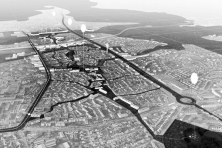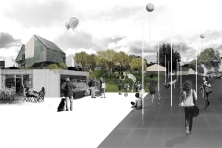Metacenter : the emergence of a garden territory
Saint-Herblain (FR) – Winner
TEAM DATA
Team Representative: Jean-Rémy Dostes (FR) – architect urban planner; Associates: Nicolas Beyret (FR) – architect; Claire Jeanson (FR) – architect urban planner; Gabriel Mauchamp (FR) – Landscape architect Urban planner
Contributor: Paul Jaquet (FR) – architect; Antoine Pinon (FR) – architect urban planner
Atelier Chuck, 65 rue Servan, 75011 Paris – France
+33 6 89 14 11 48 – contact@atelierchuck.com – atelierchuck.tumblr.com
See the complete listing of portraits here
See the site page here

G. Mauchamp, J.-R. Dostes, P. Jaquet, A. Pinon, N. Beyret and C. Jeanson
INTERVIEW
1. How did you form the team for the competition?
Most of the 6 team members met in the same Parisian company. The Europan project was born out of a desire to work together and confront our ideas and working processes outside the professional and “ordered” frames of companies. We quickly felt our characters, ideas and competences could be complementary and make up quite an explosive association.
We created “Chuck” as we shared similar urban convictions, but also a will to find reflection time freed from market constraints (nowadays particularly complex for young architects and urban planners) – “Chuck” is more than a credo, it is an exchange platform, an idea of the city, an encouragement to gather in parallel to our respective experiences.
We chose Saint-Herblain out of conviction, but also as a challenge. We consider the subject of the adaptability of the diffuse habitat (individual or residential in particular) as a subject of the future that has not been much studied yet, apart from the BIMBY strategies for example. Besides, we chose Saint-Herblain as the site left us in the greatest perplexity: none of us could give any a priori answer, which challenged us!
2. How do you define the main issue of your project, insisting on how you answered on this session main topic: adaptability and urban rhythms?
Preux is a garden-city from the 1980’s that progressively lost the “utopian qualities” that made it famous –social diversity, village-like life quality– and that was confronted to several urban pressures: road and commercial infrastructures, public transportation…
We quickly realized that we could never find any satisfying answer within the neighbourhood itself but that we had to go out of the sectoral approaches, change scale and consider a wider, more complex and richer territory.
The project therefore encompasses the scale of the peripheral territories of the greater Nantes metropolitan area, and imagines a dialogue and mutual assistance between the bigger mono-functional entities like commercial centres, the university or areas of activity (the so-called urban catalysers) and the districts gathered around one unique and isolated centre (the so-called centripetal districts), enabling the progressive building of more complex territories for common projects: the Metacentres.


3. How did this issue and the questions raised by the site mutation meet?
As the district already existed and had been awarded a prize we considered the city brief mainly as based on the (re-)adaptation of the district to a new context and the challenges of tomorrow.
We tried to show that the territory, in a way already presents the keys to its own adaptation and articulate very contrasted urban fabrics. It is indeed an incredible territory, with main road axis, convergence of public transportation, a shopping mall, regional scale equipments, ecological corridors… This is an opportunity! The territory around Preux has the capacity to embody a real change, an urban laboratory, a possibility of making the city differently. The project therefore suggests to combine two approaches: one "top-down" –very strategic, at the metropolitan scale– and the other "bottom-up" –divided in time and negotiated, starting with the existing strengths on site.
4. Have you already treated this issue previously and could you present some reference projects that inspired yours?
Working on adaptability requires an initial investment, a long-term bet often not very compatible with electoral or real-estate development times, but it establishes a real and recent awareness stressed by the economic difficulties of the housing industry.
Some of us have been collaborating for years with the ANMA office on the notion of “negotiated urban planning”, a.o. on the development program of the Bassins à flot in Bordeaux (FR). This idea turns upside down the methods and practices of urban planning that contributes to making the city more adaptable: workshop organisation, notion of upgradeable work guide, integration of actors (landowners, promoters, technical services…) and building of a common culture around the project, etc.
Some members of Chuck also studied the question of Adaptability in a more prospective way, a.o. with the “Adaptable Street” project – a reflection on the upgradeable potential of large underground infrastructures (parking lots, subways, networks…), which are the basis of our cities. This project was awarded by the “Designing Adaptable Futures” competition organised by the “Adaptable Futures” study group of the Loughtborough University (GB), which has worked for many years on this new contemporary issues and organises lectures, competitions and workshops in which Chuck took part.
They also studied this issue through a study for the Île-de-France region (FR) –via the urban creation workshop around the region master plan– that questioned the potential futures for 2030; we developed a reflection on the constitution of large scale “Metropolitan Public Spaces”. These territories were “learning from the Bois de Vincennes”: a space with phenomenal capacities of adaptation and conservation of the urban values, allowing thinking differently about the evolution of the large spaces of back lands or between-cities (mixes of agricultural spaces, activities, fallow lands and land reserve…)
5. Today –within the era of an economic crisis and sustainability– the urban-architectural project should reconsider its production method in time; how did you integrate this issue in your project?
The more we drew, the more we had the feeling to fix a project and therefore the future of the district.
Our first reaction was to connect the districts, make them ”discuss”, as a theatre play and watch what could happen there… In this sense, it is mainly a process-project around a central public space, allowing the progressive constitution of a territory for the project that would be recognised by the actors and inhabitants, a place that could taken over and equipped with sustainable capacities: development of the exchanges and the possible, production of local added values on the long term (local initiatives, synergy between the various economic productions, short networks, mutualisation).
The process includes “minimal conditions” (link, qualify) with an adjusted “governance body” –l’Atelier du Métacentre (the Metacentre Workshop)– allowing the definition of “key actions”. The Workshop articulates the scales of the larger city, the metacentre and the individual and therefore sets the basis of a sustainable management of the territory providing with the possibility to confront different actors, even atypical ones (associations of citizens, craftmen, farmers, marketers, solar panel installers, artists, children), as well as to set temporalities and urban opportunities in parallel.
6. Is it the first time you have been awarded a prize at Europan? How could this help you in your professional career?
It has been for most of us the first participation to Europan. Winning Europan worked as a starter and helped reinforce the Chuck collective. It comforts us in the idea that we currently need to create collaborations and methods to accompany the cities and the transformation of more and more complex territories.
Chuck materializes the old wish to invest in certain fields that nowadays are at the margin of operational practice of urban planning: tourism, rural urban planning, employment, suburbs… These prospective notions correspond to the Europan philosophy, which for the past last years has been trying to better anchor urban issues into their project territories.
The variety of profiles and work experiences within Chuck –group of architects, urban planners and landscapers with experiences in graphic design and photography– offer us a capacity of adaptation and a prospection strength that stimulates our will to go on in the Europan dynamic along with the actors of life in Saint-Herblain. And also gives us the will to gather again and expand our experiences with new cities and around new stories.